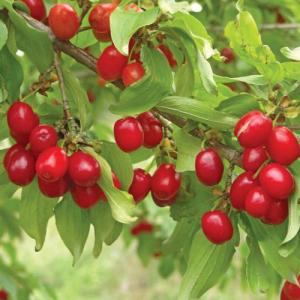Plant dogwoods in partial shade for best results
Plants that are now considered decorative often have a history of being used for almost everything but decoration. Spring brings the dogwood to bloom, setting off bursts of white flowers in dark woods and hedgerows. But the dogwood is more than a pretty face. The settlers used dogwood twigs as toothbrushes. Dogwood timber is fine-grained and very dense, making it one of the strongest, hardest woods used for tool handles and even roller skates. But you can also eat dogwood fruits.
There are now dogwoods bred just for their fruits. Also called Cornelian Cherry (Cornus mas), these small trees are beautiful all season long, from their yellow flowers that burst open every spring before the trees even have any leaves, to brilliant fall color when the leaves turn striking reds and yellows. The variety Red Star (Cornus mas) has bright yellow flowers that grow into a very heavy crop of pungent but tasty, glossy crimson-red, oval fruit. These one-and-a-quarter-inch-long fruits make tasty jams or preserves. This ornamental tree stays small, growing to just 10 to 15 feet tall. You will need another dogwood (Cornus mas) as a pollinizer. Red Star is quite hardy, able to withstand winters in USDA Zones 4-9. Kazenlak (Cornus mas) is a Bulgarian cultivar of dogwood with even larger fruits. These one-and-a-half-inch-long fruits turn dark red, and have a deep, rich flavor. There are even Cornelian Cherries with yellow fruits for a nice change of pace. Some of these dogwoods sport variegated leaves with white and green splashed together for an all-season display.
Plant dogwoods in partial shade, though they can tolerate full sun. Dogwoods prefer slightly acidic soil. If your tree is bare root, soak it in lukewarm water for about four hours. This will rehydrate the roots. Dig a wide hole so the roots can spread out without bending. Make a slight hill in the middle of the planting hole so the part of the trunk where the roots join is just slightly above ground level. Pack the soil in around the roots, and tamp it down so there are no air pockets. Water thoroughly and finish with a four-inch mulch to keep weeds down and the soil moist.
Because drought-stressed trees are more prone to insect damage and disease, be sure to keep the tree well watered during the first year. Once they’re established, you probably won’t need to water dogwoods at all unless you have a severe drought. You can plant container-grown dogwoods anytime, but bare-root trees do best if transplanted while they are dormant.
After the first year or two, you can fertilize dogwoods with any organic slow-release fertilizer. Go easy on fertilizer; it can kill young trees, so it’s best to err on the side of too little fertilizer rather than too much. A side dressing of compost in early spring is often all the trees need. You can even grow dogwoods from seed collected in the fall. Soak the fruits for a few days and gently rub the seeds out. Plant the seeds immediately.
For spring color in the understory of larger trees, plant dogwoods. They will soon become a favorite for wildlife and add something unusual to the table. While you may not be able to have your cake and eat it too, you can have a strikingly beautiful flowering dogwood tree and eat it too.














































